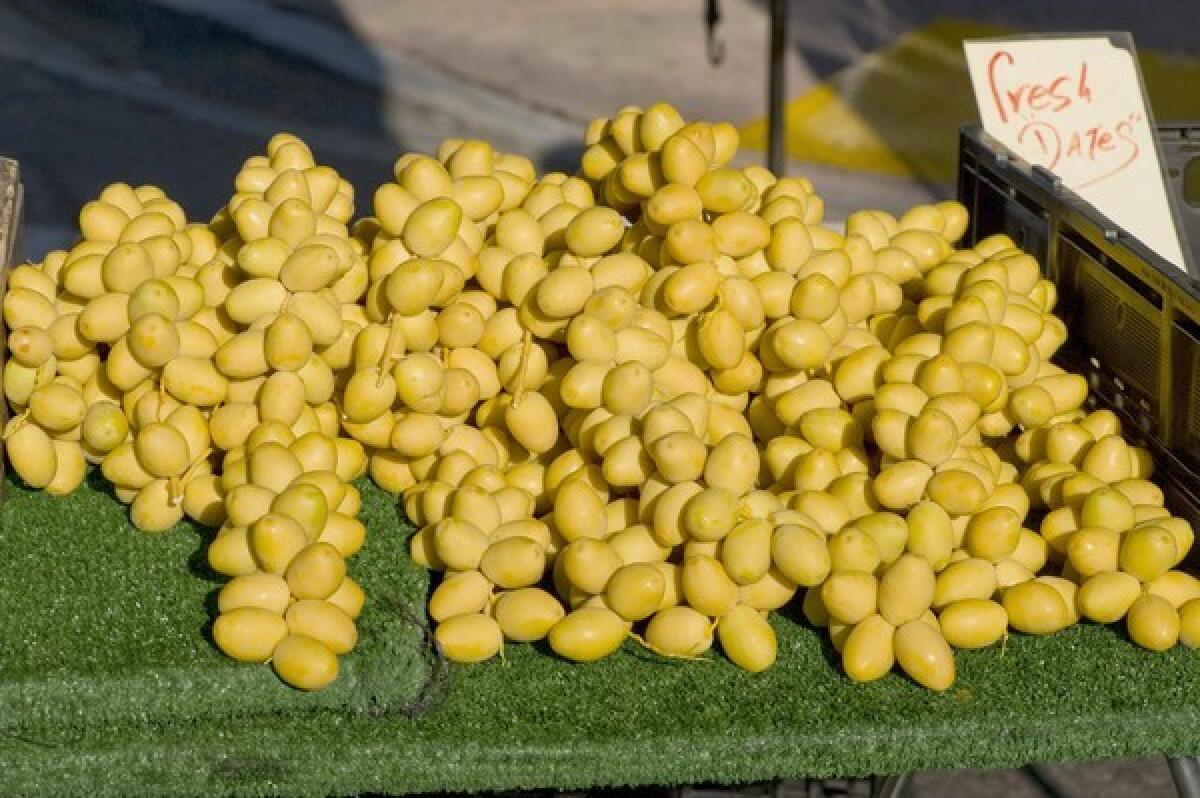Market Watch: Fresh dates — Barhi, Medjool and more

- Share via
Dates can keep in refrigeration for years and are available year-round, but the freshly harvested fruits, which started showing up last week, are far superior in texture and flavor, and are one of the great seasonal treats available at Southern California farmers markets.
Most distinctive is the Barhi variety, picked at what is known in Arabic as the khalal stage of maturity, when it is yellow, firm and crunchy, with a flavor of coconut, sugarcane and cinnamon. Most of the leading date varieties, such as Medjool and Deglet Noor, are high in tannins at this stage and thus too astringent to eat with pleasure. But when properly mature — that is, bright yellow, without any greenish tinge — Barhi has just a touch of astringency, which complements its sweetness.
Photos: David Karp captures what’s fresh at the farmers market this week:
If small brownish dots are starting to appear on the fruit, that’s not rot but a good indication of full maturity. If yellow Barhis are left on the kitchen counter (not in the refrigerator), they will gradually soften, like Hachiya persimmons, and arrive at the rutab stage much appreciated by Middle Easterners and date connoisseurs. These fruits are amber or light reddish brown, soft, moist and delightfully free of stringy fibers, so that eating one is like biting into a caramel cloud. They can keep in refrigeration for several months and still taste good, but as the moisture seeps out, a pocket develops between the fruit and the skin, which turns brittle and is best peeled off, if you don’t mind getting your fingers sticky.
The Barhi’s flavor is “mild and extremely delicate, rich yet not heavy or cloying,” wrote Paul Popenoe, scion of a famous exotic fruit nursery family and agricultural explorer (later a marriage counselor and eugenicist) who imported offshoots of the variety from Basra, Iraq in 1913. It is grown on modest acreage in the Coachella desert for shipping khalal fruits to Middle Eastern and specialty markets during the brief season, September and early October. Rutab Barhis, which should be refrigerated if kept for more than a day or two, are too delicate for commercial shipping (even mail order is dicey), so farmers markets are the best source.
For pride in the quality of his Barhis, no one beats Robert Lower of Flying Disc Ranch, in the aptly named community of Thermal, where it was a mere 119 degrees Tuesday. His vendor Christina Kelso will have yellow Barhis and soft Medjools starting next Wednesday at the Santa Monica farmers market, and soft Barhis in two weeks.
In the Middle East and North Africa, where dates are native, there are many nonastringent varieties that are sold in the firm khalal stage, but here in the United States, Barhi is the only such variety grown commercially. There are a few nonastringent varieties of American origin, however, such as the yellow-skinned Mariana, likely a seedling of Halawy from Indio that is grown exclusively by Doug Adair of Pato’s Dream Date Gardens, who sells at the Alhambra farmers market and by mail order. In a few weeks he will also offer dark purplish red khalal fruits of the prized Black Sphinx variety, which originated near Phoenix before 1920, as well as soft Barhis and Medjools.
Good yellow and rutab Barhi dates are widely available at farmers markets from Bautista Family Organic Date Ranch of Mecca, which sells at Torrance, Long Beach Marina, Hollywood, Santa Monica Wednesday and many other venues. Bautista has also started to bring rutab Khadrawy and Honey dates, both of which have soft, melting, caramel-like flesh.
Pitahaya, or dragon fruit
Specialty farmers have grown pitahayas for close to a decade in California, but they’re still rare enough that many shoppers stop and gape at Pedro Gallardo’s display of the large, flaming-pink spineless cactus fruits. Native to Central America, and widely grown in Southeast Asia — where they are known as dragon fruits — pitahayas, depending on the variety, can have white, pink, or magenta flesh, the latter so phantasmagorically saturated that you’ll think that you’re back in the 1960s. Embedded in the flesh are little black seeds, crunchy and edible, similar to a kiwi’s.
The flavor also varies by variety and ripeness, from sweet to sweet-tart to bland. Generally it is pleasant and refreshing, reminiscent of watermelon with a vegetal note, but not as spectacular as the appearance. The price — $8 a pound at a recent market, for specimens that range from a half-pound to more than a pound — is high enough so that most people probably won’t make a staple of this fruit, but it is worth sampling and buying occasionally.
Gallardo, who owns an acre of pitahaya in the De Luz district of Fallbrook and also draws on the larger planting of his neighbor Henri Gerwig, sells at 25 farmers markets, including Huntington Beach, Torrance, Santa Monica Organic, Hollywood and Long Beach Marina.
More to Read
Eat your way across L.A.
Get our weekly Tasting Notes newsletter for reviews, news and more.
You may occasionally receive promotional content from the Los Angeles Times.










